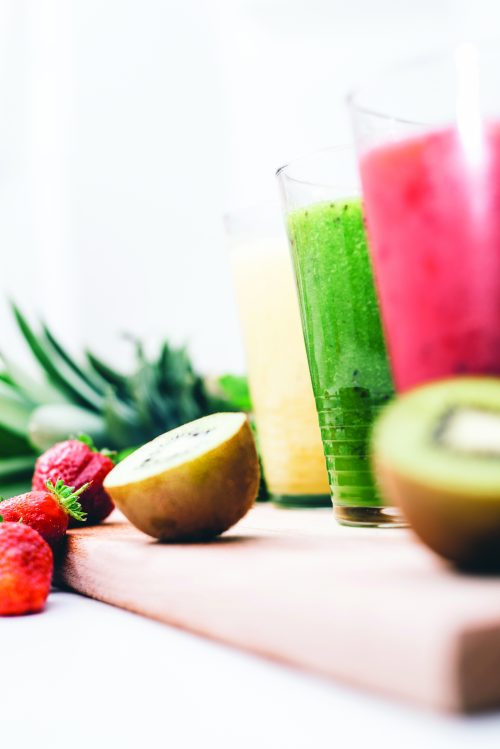
With personal blenders all the rage, HFG nutritionist Claire Turnbull busts some myths around juices and smoothies.
What’s the difference between a juice and a smoothie?
Juices are made by squeezing or pressing fruits and/or vegetables. The liquid extracted is juice and the fibrous remains of the fruit or vegetable are discarded.
What’s in a smoothie varies greatly, so how good it is for us also varies! Most commonly, smoothies are based on fruit — either fresh, frozen or canned. Sometimes vegetables like spinach can be added, plus in some a liquid to blend it all together, e.g. milk, water, coconut water or fruit juice. Other ingredients can include yoghurt, protein powder, nuts, seeds, cocoa powder, honey, dates, syrup, and, in more indulgent smoothies, ice cream.
Which is better for me?
A smoothie made from a balance of nutritious ingredients is generally a better choice compared with most juices. Juices are a concentrated source of sugar without any fibre. Smoothies can be made with whole fruits and vegetables (including the skins), meaning the fibre isn’t lost.
Juices made from low-sugar vegetables like celery, cucumber or lettuce, with a small amount of fruit or sweeter vegetables like carrot and beetroot, are a better option than fruit juices but are not always available. You can make them yourself, or order them specially at a café or juice bar.
What’s good about juices and smoothies?
Juices can be a good source of vitamin C and other nutrients. However, they are a concentrated source of sugar, so you need to think about the quantity you consume.
Made right, smoothies are an easy and tasty way to get fruit, veges, low-fat dairy and healthy fats in one go. They are super-convenient and you can make so many different varieties you’ll never get bored with them.
Is a smoothie a good idea for breakfast or a snack?
Made with the right balance of ingredients and in an appropriate portion size, a smoothie makes a great breakfast or snack. But since variety is the key to good health, alternating smoothies with other healthy breakfast options is a great way to go.
If you want to drink a smoothie to keep you feeling full, make it with low-fat milk and/or yoghurt for a protein boost; you can also try adding a tablespoon or two of oats, as well as nuts and seeds.
What are the potential pitfalls?
Juice
A glass of fruit juice used to be considered one of our daily serves of fruit, but this is no longer the case. We are far better eating our fruit whole than juicing it. Whole fruit contains fibre which requires chewing and it fills us up whereas fruit juice is high in energy, lacks fibre and isn’t as satisfying.
By juicing fruit and veges we can end up with a drink which is very concentrated in sugar. One cup of some fruit juices can contain the equivalent of 6 teaspoons of sugar. The World Health Organization’s recommendation is for no more than 12 teaspoons of free sugars daily. Sugars found in juice, despite being ‘natural’, are considered free sugars. Some juices contain additional sugars, too.
Smoothies
A smoothie can be a great source of nourishment, but it is easy to add ingredients which can make it more like a dessert than a healthy drink.
- Adding fruit juice to smoothies isn’t a good idea as it is adding sugar; water or trim milk are better choices. Be aware that bottled, pre-made smoothies contain mostly fruit juice, with just a small amount of other ingredients.
- It’s easy to add a lot of fruit to a smoothie, but most of us need only two servings of fruit a day. One serve of fruit in a smoothie is a good way to go. That way you can enjoy another serve of fruit later in the day!
- Adding honey, maple syrup, dates or other sweeteners directly adds to the sugar content. Less is best.
- With green smoothies check what you are getting as there is a huge difference between a true green smoothie, made from spinach, cucumber and a few slices of apple, and a ‘green’ fruit smoothie, made with a banana, apple, fruit juice and a few spinach leaves or a sprinkle of spirulina powder.
- Portion sizes can easily expand, especially if you are making smoothies at home and not measuring the ingredients.
Some great smoothie combos
- Banana + low-fat milk + rolled oats + peanut butter
- Berries + spinach + low-fat milk + LSA
- Spinach + banana + water or low-fat milk
- Carrot + mango + coconut + mint + water
- Spinach or kale + pineapple + banana + grated ginger + water
How much sugar is in my juice or smoothie?
Green ginger buzz smoothie
27g sugar
The Homegrown Juice Company
Raw + green fruit smoothie with spirulina, wheat and barley grass 400ml
34.8g sugar
Charlie’s
Honest squeezed orange juice 500ml
47g sugar
Simply Squeezed
Spirulina slam smoothie 350ml
50.1g sugar
Homemade smoothie
1 cup juice + 1 banana + 1 apple
55g sugar
Chewing is good for you. There is huge value in chewing your food yourself as it helps your brain register that you are eating. Not everything needs to be blended up to be good for you!
www.healthyfood.com










